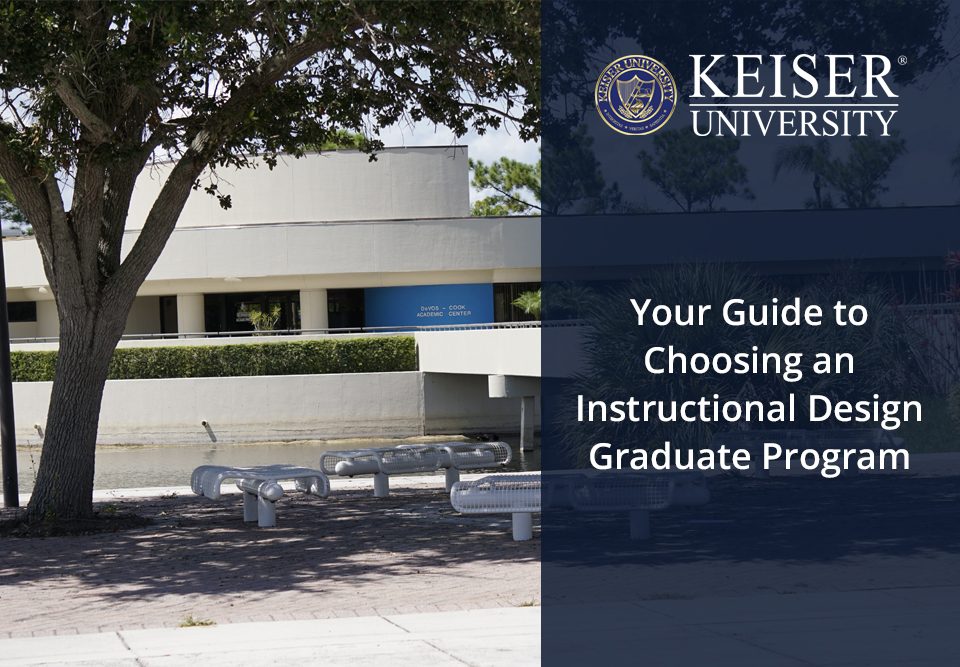The interest in and demand for online education is at an all-time high. The pandemic pushed schools and universities from dabbling with online learning environments to using them for full-time education experiences. According to Research.com, the total global eLearning market is expected to reach $336.98 billion by 2026. In 2018, more than 30% of American college students were taking at least one online course, and that number grew with the COVID-19 pandemic. Online learning is not limited to the college level, either. Many elementary and secondary schools now offer online or hybrid learning environments, both for traditional students and for those who do not attend school on campus.
This tremendous growth has caused a renewed focus on graduate-level work in instructional design and technology. If you are looking toward this field for your grad school experience, here is a guide to help you choose the right degree or certificate program.
Instructional Design and Technology Overview
As online education continues to grow in importance, the need for professionals well-versed in instructional design and technology also grows. Instructional design and technology is a field of study that teaches educators how to design, create and deliver instructional experiences using technology, both in the classroom and in online education environments.
This is a diverse field of study that can have many potential career paths. People with a graduate degree in educational design and technology can find work as:
- Instructional designers
- Instructional technology specialists
- Education specialists or consultants
- Technology coordinators
- Deans of distance learning programs
- Directors of distance learning programs
- Specialists for distance learning programs
Instructional design and technology is a somewhat new field within education, but it remains an important one for those who want to work with technology while remaining in the education field, or bring education to a different field.
Start with Your Goals
Before deciding which degree program is right for you, you need to decide your goals for your career. These goals can include the length of time you want to spend in graduate school and the type of role you want to pursue after you earn your degree.
For example, if you picture yourself as an instructional designer and already have a master’s in education, you may need to pursue a PhD in Instructional Design and Technology, which is a doctoral degree in the field. If you want to lead an online learning program, then an EdS in Instructional Design and Technology may fit better. This is an interim degree between a master’s and a doctorate. While there is much overlap in these degree programs, you can evaluate your goals and then review the program’s classes to determine which will give you the skills you need.
If you have already completed some graduate coursework but want to move into the instructional design field from a different educational field, then a certificate may be all you need. If you have not completed any graduate work, then a Master of Science in Education, Instructional Design and Technology is a great starting point.
In addition, while considering this component of the decision, you can look at the skills or knowledge you already have. Choose a program that will fill in the gaps to prepare you for your future career.
Locations and Online Options
Next, consider the location of the program. If you plan to attend class on-campus, you may want to choose a school that has a campus close to home. Or, if you are willing to relocate during the time that you are attending school, choose a campus near housing and the amenities or job options you need during graduate school.
An increasing number of instructional design and technology graduate programs are offered in online environments. This structure allows you to choose a school based on the merits of its faculty and program while continuing to work, live where you currently live and fit school around your other responsibilities. If you need flexibility and cannot move, then an online option would work well. Keiser University, for example, offers three graduate school programs in an online environment. This provides the convenience of online education and the quality of a trusted academic program.
Faculty and Staff
The quality of your education program is equal to the quality of your school’s teaching staff. Look for a program with qualified faculty that will deliver an excellent education.
Knowing you should evaluate faculty and knowing how to do so are two very different things. Data on student rankings and evaluations of the program is one way to evaluate the quality of the staff. Another option is to look at the education and work experience of the staff. On the doctoral level, you can also read the published works of the teaching staff. These tools will help you determine if the staff is of high quality and will provide an education that improves your skills.
Tuition and Costs
The cost of tuition is always a factor to evaluate if you are considering graduate school programs. That said, there are other factors involved, like the quality of education, location, faculty, etc. While saving money on tuition is certainly a positive it can come at the expense of other factors. Outside of the tuition for classes themselves, make sure you account for books, school materials, technology and other non-tuition costs.
Financial Aid
Financial aid is available for graduate and post-graduate students who qualify, according to The Balance Money. The first step is applying for financial aid to determine a funding plan that meets your specific needs. This is done by completing the Free Application for Federal Student Aid (FAFSA).
On the doctoral level, you may be eligible for research grants or fellowships to help pay for some or all of your graduate training if you enter a research-based degree program. These are private grant programs, so start looking for options in education and technology-related companies to see what is available. According to GoGrad.org, many doctoral-level candidates have most, if not all, of their programs paid for through this type of financial aid.
Program Prerequisites
Graduate-level programs in instructional technology will have program prerequisites. For many doctoral programs, including those at Keiser, the prerequisite is a master’s degree in a related field from an accredited university or college. Some require the GRE, while others look at your previous graduate work without needing the exam.
Transferring Credits
If you have already taken some graduate- or doctoral-level credits at another institution as part of your continuing education, you may be able to transfer those credits to your new instructional design and technology program. Most programs have a limit on the number of credit hours you can transfer. For example, Keiser’s master’s and EdS degrees in institutional design and technology allows up to 12 transfer credits, while the PhD allows up to 18 transfer credits. Talk to your admissions team about the potential of transfer credit hours for your new degree.
Degree Options
There are three basic degree options if you are looking for graduate work in instructional design and technology. In addition, you can pursue a certificate in this field instead of a degree. Here is a closer look at each option.
Certificate Vs. Degree
A certificate in instructional design and technology is a short program that requires between four and eight courses. This is the most affordable way to add instructional design and technology to your skill set. It will focus on teaching one specific skill set within the field but may not discuss overall education concepts. For example, the eLearning design certificate would teach you how to design learning environments for digital classrooms but not how to create learning goals to fit the digital environment.
A degree digs a little deeper into all aspects of instructional design and technology. It will look at education theory, planning and outcomes as well as the tech side of the equation.
The answer to which one you need will depend largely on what you hope to do with your knowledge. If you just want to add a little instruction to your plate, then a certificate may work well. If you need to step into a new role, that role may demand a degree.
EdS
If you are looking for a graduate degree and already have a master’s degree, then an Education Specialist degree (EdS) could be a good fit. This is not a doctoral program but rather a step between a master’s and a PhD, without requiring a dissertation. An EdS in Instructional Design and Technology program teaches how to use emerging technologies to create positive learning environments in a digital space. It also teaches students how to apply current education best practices to developing digital learning environments.
MSEd
A Master of Science in Education, Instructional Design and Technology (MSEd) is a great choice if you’re an educator entering grad school for the first time and want to pursue educational technology. It provides the same educational foundation as a standard education master’s degree program with the added benefit of instructional design education. This program will equip you to design and use online learning environments and the technology associated with them.
PhD
A Doctor of Philosophy in Instructional Design and Technology (PhD) provides in-depth training in this field. This degree sets the stage for leadership roles within education and allows you to partner with your school to advance the body of knowledge in this field. If you want to be at the forefront of advancing educational technology and you already have a master’s degree in education, this could be the right fit for your goals.
EdD
There is an additional terminal degree option specific to education, a Doctor of Education. An EdD in Instructional Design and Technology is designed to be more practical for those educational professionals who prefer to use their highly trained skills in practice rather than teaching or researching. Whether it means pioneering new approaches to developing training or adapting new technology to education, Doctors of Education are at the forefront of their field.
Talk with the School
If you are unsure about the best degree program to consider, start a conversation with your school’s graduate department. They will help guide you toward a degree or certificate that will help you reach your career goals. They will also help you know what credits you already have that may transfer to your new degree.
Keiser University’s graduate school is ready to welcome you. Whether you are looking for a PhD, MSEd, EdD, or EdS program, we have one to fit your needs. All of these programs are conveniently online for your flexibility and scheduling needs. We do not require the GRE for any of our online master’s or doctoral programs in instructional design and technology. Reach out to our graduate school today to discuss applying and see what advancement opportunities are available with help from Keiser University.






 My instructors believed in me. They were more than instructors, they tried to get to know you as a person and tried to understand your goals so they could push you towards them. Student services helped me find a job before I even graduated. Everyone was dedicated to my overall success.
My instructors believed in me. They were more than instructors, they tried to get to know you as a person and tried to understand your goals so they could push you towards them. Student services helped me find a job before I even graduated. Everyone was dedicated to my overall success.
